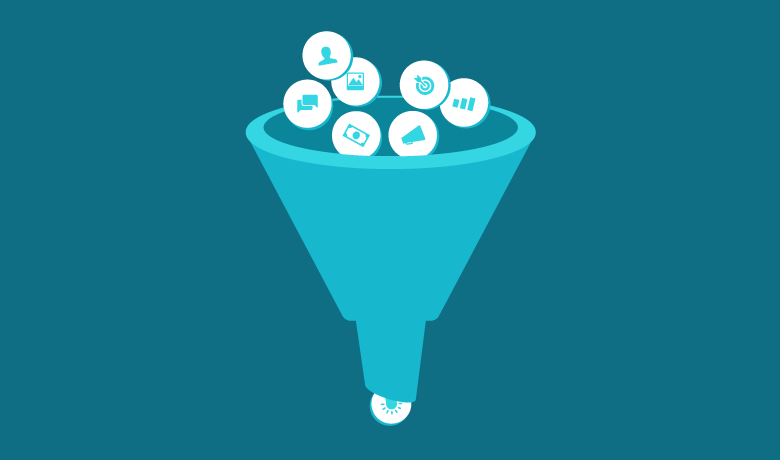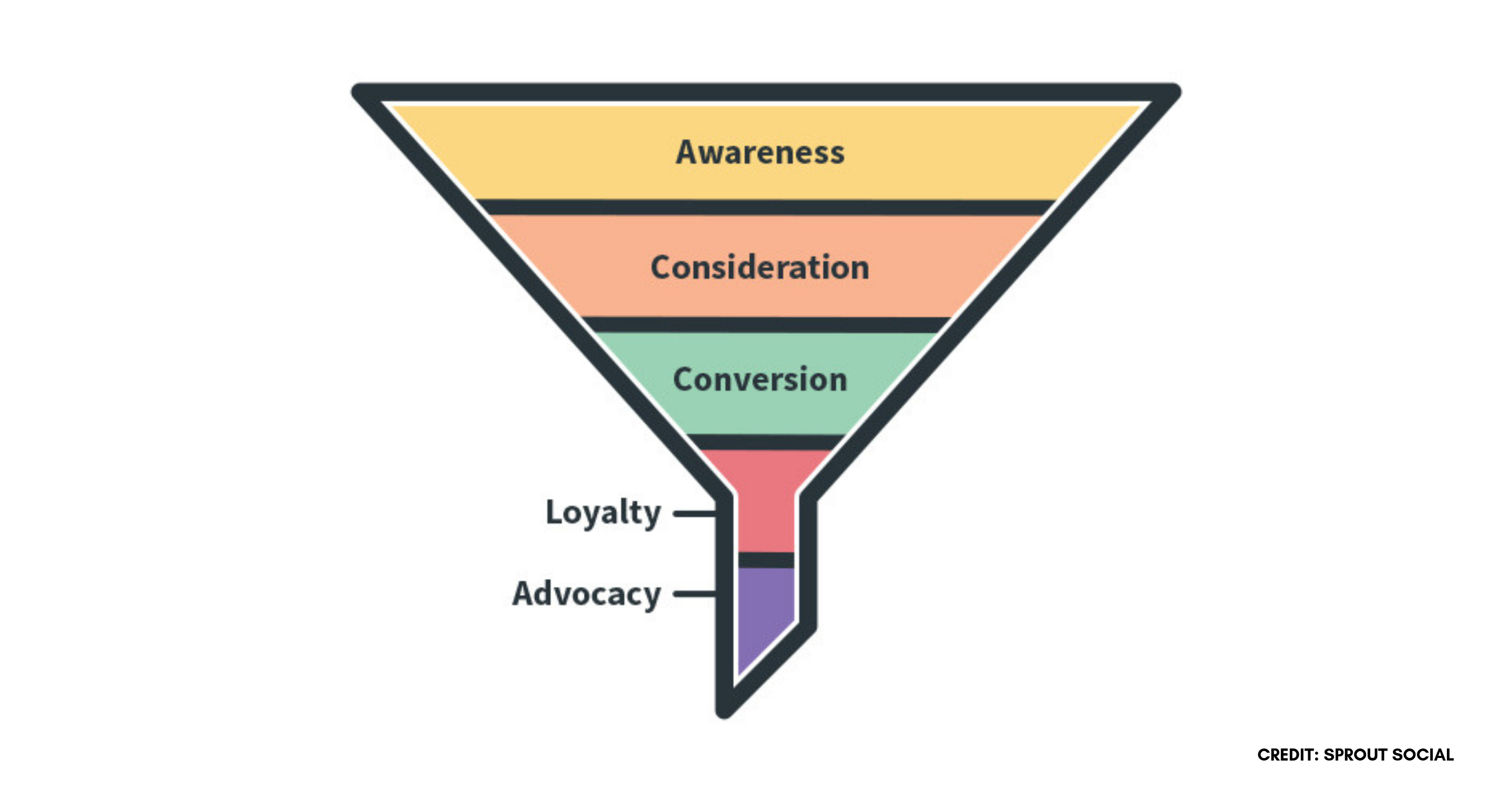How to build a social media marketing funnel that converts
Written by Sarah Aboulhosn
Published on February 19, 2020
Reading time 8 minutes

There are hundreds of strategies out there when it comes to marketing your brand using social media. These strategies encourage creating content, building a social media marketing calendar and orchestrating creative campaigns to keep your audience engaged.
But when it comes to building a customer journey that takes potential customers who are hearing about your brand for the first time to a point where they become brand advocates and recurring buyers, there tends to be a gap.
In this article, we’ll break down the five phases of the marketing funnel. By the end, you’ll understand exactly how social media fits into each stage.
What is a social media marketing funnel?
A marketing funnel is a path that your customers travel through. From the initial stages when someone learns about your business, to the purchasing stage, marketing funnels map routes to conversion and beyond.
With careful analysis, a marketing funnel lets you know what your company must do to influence consumers at certain stage. It starts the moment they become aware of your brand and continues until after they make a purchase. The social media marketing funnel ends with a customer becoming a true advocate of your brand.
Different industries and experts might have varying opinions on the phases of a social media marketing funnel. Despite what you call the phases, there is a basic framework to a customer journey that ultimately results in a sale and long-term brand advocacy.
The most common social media sales funnel framework, and the one that applies to most businesses, consists of five phases:
- Awareness – Attracting new people who are currently unaware of your brand.
- Consideration – Standing out among your competition so that new audience members remember you.
- Action – Compelling your audience to take action and make a purchase.
- Engagement – Using social media to stay top-of-mind and keep your audience engaged after they’ve purchased.
- Advocacy – Building enough trust with your audience that they want to recommend you to others.

So how does social media fit into these phases?
If social media is a significant part of your marketing strategy, you’ll be able to incorporate social posts into each stage of the funnel. Depending on the platforms you use, you can guide your audience through the customer journey organically.
The marketing funnel works as a unified whole. When every section works towards specific goals, friction in the journey is reduced, creating a customer journey that continues to build trust with your audience and raise awareness of your brand.
Streamline your social marketing funnel with Sprout Social
Sprout can help you make every step of your marketing efforts more efficient.
Plan posts and tag them by funnel stages so you can find out where your funnel is working and where it needs more attention.
Test out Sprout with a 30-day free trial to see how it can enhance your marketing efforts.
1. Awareness
The social media marketing funnel begins with potential customers finding your brand and becoming aware that you exist.
As a business, you should be able to identify a problem that your audience needs help solving. Even if your audience is not aware of your brand, you can relate to them by offering a solution to a common problem.
This initial touchpoint is not the time for a hard pitch of your product or services. The goal is to offer value and support. This information should be valuable enough that potential customers remember your brand and seek more information on who you are.
Instead of just promoting your product, create content that answers your customer's questions and solves their problems. https://t.co/PYc0BOKEXJ
— Sprout Social (@SproutSocial) February 14, 2020
Show the value of your business through content, such as blogs, videos, guides and webinars. Answer the questions your audience is searching for will bring potential leads to your website, where you’ll have the opportunity to build more awareness and trust.
If your budget allows for it, use paid advertising to improve awareness. By targeting a specific audience or interest group, you’re specifically targeting people who may be dealing with the problem you’re aiming to solve.
When creating blog content, utilize SEO and content marketing to attract new users organically.
Canva does a great job of targeting key phrases that they know their target audience is searching for and creating value-based content around those topics.

Canva also heavily promotes their blog posts on their Twitter Profile.
Keep audiences visually engaged with a slick, well-designed presentation.https://t.co/ykfBWDGIBF
— Canva (@canva) January 31, 2020
Video marketing also works very well in the awareness phase. If you can create videos for Facebook or Instagram or useful tutorials on YouTube, you can increase your chances of new users finding you organically.
Seattle Coffee Gear uses YouTube to share educational tutorials about how to make different types of coffee. While these videos lightly mention how to use their products, the main emphasis is on how to make coffee.

Viewers can apply the information to most brands of coffee equipment. They create valuable tutorials for coffee lovers with the hopes of becoming the viewers go-to coffee making resource.
2. Consideration
As potential customers continue through the marketing funnel, they begin to look for more specific information when considering whether to buy into your product or service. This includes researching why you are better than your competitors.
During the consideration phase is when you provide more detailed information to guide potential customers into the action phase. Providing potential customers with the right information such as case studies or webinars can help build more trust during this phase.
Zapier uses Facebook Ads to retarget users who have interacted with their website or content. They recognize that users may have visited their site to read their content and watched video testimonials as social proof. In this video, a customer tells her story about how she uses one of Zapier’s features to automate her business, a pain point Zapier was able to address.

For B2C companies, the consideration stage might involve customer testimonial campaigns, in-depth product tutorials or product reviews on your Facebook Business Page.
Makeup brand The Quick Flick uses their Instagram Business Profile to share dozens of makeup tutorials on how to use their product as a part of an everyday makeup routine. For most viewers, this is not their first exposure to the brand, but these videos work to build more trust and confidence in the product’s uses and capabilities with their audience of makeup lovers.

Published in the Sprout Social Index, 45% of consumers said they are more likely to research a product or service when someone relatable, like an employee, posts about it, and 32% of consumers react similarly when a celebrity or influencer posts about the same thing.
3. Action
If you’ve nurtured the relationship up until this point, customers should feel receptive being sold to at this stage of the funnel. Check the data from your analytics to see how most of your audience has engaged with the previous phases.
During this phase, it’s convenient to use a social media management platform like Sprout Social. Sprout’s analytics and reporting features track your data and measure whether your paid social media ads received enough engagement, so you can see if you’re reaching your goals from earlier stages of the funnel.

With Sprout, you can view analytics for each platform to determine the best way to generate a sale.
Trust that your audience has made it this far through the funnel and that sales will come in during this stage. Continue to nurture potential customer relationships until they are ready to convert.
It’s okay to gently nudge your customers to take the leap and make a purchase, like offering purchase incentives like a new customer discount or free shipping. In fact, about 40% of consumers said they would most likely engage with discounts or offers.
During the action stage, use remarketing paid campaigns to target users who have shown interest by engaging with previous parts of your funnel.
Casetify uses discounts and holiday promotions to give shoppers an incentive to buy their phone cases. As an example, they promote these offers with Instagram ads that target users who have previously interacted with their brand.
4. Engagement
It’s important not to forget about your audience once you’ve made the sale. It’s common for brands not to focus as much time on this part of the funnel.
It might seem like since a customer has made a purchase that they’re a lifetime fan, but that’s not always the case. You still need to continue to nurture the relationship to stay top of mind.
Stay connected with your customers and make them feel like they are a part of your brand community. Do this by creating social media content that supports them based on the purchase they made.
Essie created their #essielove hashtag to encourage people to post photos of their nail polish in action. The hashtag gives customers the opportunity to share their content with Essie’s 2 million followers.

Hashtag campaigns can make users feel like they are a part of a community and encourage continued brand loyalty. For less visual brands, you can also use a similar strategy on Twitter by creating a hashtag or organizing a Twitter chat.
SEMrush conducts weekly #SEMchats on Twitter. These chats attract SEMRush users as well as other people in the digital marketing space.
Hey, #SEMrushChat‘ers! We are happy to announce that this week we are going to have the whole panel of amazing special guests 😱 Please welcome — @hamletbatista @marthavanberkel and @jasonmbarnard 👏 This time we’ll be discussing schema markup & why it’s Important for #SEO! pic.twitter.com/OAhGw5hdKo
— SEMrush (@semrush) February 4, 2020
For B2B or SaaS companies, the engagement phase can involve sharing tutorials. Some brands also choose to create a private Facebook Page or community for users to connect with them and each other.
5. Advocacy
You’ve made the sale and added value following your customer’s purchase. It’s time to take the funnel one step further.
Now is when you convert your customers from fans into brand advocates.
Show gratitude to your customers and reward them for spreading the word about your brand. Gather customer testimonials and reviews or offer incentives that encourage customers to share their journey with their friends.
Dropbox exemplifies this phase by incentivizing their customers to invite their friends in exchange for more storage space.

Continuing to nurture the relationship will take your customers from fans to brand ambassadors.who will organically influence their network to trust your brand as well.
Continue to build valuable content and nurture your existing customer relationships. Make it easy for customers to share their stories and advocate for your brand. Allow customers to share reviews or testimonials on your website or Facebook Business Page to voice their praises.
At the advocacy phase, work with existing customers or power users to create content.
Shopify works with users to create blog posts that share their stories of how they use the site. This content acts as a case study of sorts and positions the user as an advocate of the brand. The user gets exposure for their brand and Shopify gains social proof that they can use as marketing material.

Conclusion
Traditional sales funnels have their time and place. But social media marketing funnels can engage your audience, build trust and create an authentic base of fans for your brand.
A common mistake marketers make is to invest in only a few of these stages rather than all of them. Your audience and potential customers can sense overly sales-focused content or pitches without first building brand awareness or trust. This kind of marketing can be off putting to people who are unfamiliar with your brand. If you’re worried about having limited resources to build the funnel, then pick one or two tactics to focus on for each phase.
Incorporating the right steps into your customer journey is something that will help your brand continue to grow. Rather than building a customer list, you’re building a loyal fan base.
For more information on how to level up your social media marketing strategy in 2020, check out our free social media toolkit. It includes templates and guides that will help you turn social data into actionable insights to use in your 2020 marketing strategy.
- Categories
Post Performance Report: Brands turning IRL events into online engagement
Published on May 21, 2024 Reading time 6 minutes - Categories
What social media tasks to automate and what to personalize
Published on May 15, 2024 Reading time 7 minutes


Share